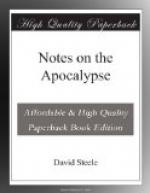Vs. 13-17.—This lamb-like beast of the earth devises another agency, by which to subserve his own diabolical interest, as well as that of the “first beast.” He causes to be made “an image” to or of the beast of the sea. Of images in general, as objects of idolatrous worship, we are warranted to say,—they are dead and dumb idols; (ch. ix. 20; Jer. x. 14:) but this one is altogether different. And it is surprising to find learned expositors fixing upon the superstitious use of the cross by the papists, as exemplifying this symbol. The Holy Spirit, as if to guard all readers against such misapprehension, declares explicitly, that this image has “life, speaks,” and acts. The only point in which this image resembles others is, that it is to be worshipped: but of all others we are assured that they “cannot do evil,” (Jer. x. 5.) This image has such “life,” (breath,) and power as to cause the death of such as refuse to worship itself. Three agents are to be noticed and clearly distinguished here,—the ten-horned beast of the sea, the two-horned beast of the earth, and the image of the beast. At the instance of the second beast, an image is made; not to or of himself, but to, and also of, the first beast. Now, as the beasts put forth their power by their horns, so this ecclesiastical beast of the earth makes the image by his horns. In short, history explains the symbols. The Roman clergy,—the horns, the cardinals, create the Pope; and, in their own ceremonial and language,—quem creant, adorant, “whom they create, they adore;” like all other idolaters. Thus, the Pope becomes the “man of sin, sitting in the temple of God, showing himself that he is God,” (2 Thess. ii. 4.) The Pope is the most perfect image of the Roman emperor; claiming the same universal dominion, the same titles and prerogatives, in the same city: but the Pope and the emperor never identify. They are always distinct. Two authoritative measures are to be specially noticed in this connexion; one by the beast of the earth, the other by the image of the beast of the sea. The image demands worship under pain of death. All heretics are judged worthy of death. All are required by the second beast to receive the mark of the first or civil beast. The penalty in this case is privation of civil and political privileges,—to “buy or sell.” It is to be noticed here that the “mark” is imposed by the authority of the ecclesiastical power, the two-horned beast. As there is liability to mistake as to which of the two beasts the “mark” refers, and as this mistake is in fact generally made by expositors, the apostle John has been directed, as in the case of the image, to be peculiarly explicit, that all may know it to be the mark of the first beast. (See chs. xv. 2; xix. 20; xx. 4.) But it will be asked,—What are we to understand by the “mark?” This question is easily answered from history. The




